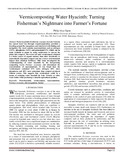| dc.contributor.author | Ogutu, Philip Ariya | |
| dc.date.accessioned | 2019-03-25T10:07:39Z | |
| dc.date.available | 2019-03-25T10:07:39Z | |
| dc.date.issued | 2019-01-01 | |
| dc.identifier.issn | 2454-6194 | |
| dc.identifier.uri | http://r-library.mmust.ac.ke/123456789/1278 | |
| dc.description | vermiculture | en_US |
| dc.description.abstract | Water hyacinth (Eichhornia crassipes) in Lake Victoria
has caused water loss through evapotranspiration, provided a
breeding ground for mosquitoes and interfered with fishing and
navigation. The weed contains macronutrients such as nitrogen
(2.5%), phosphorus (1.0%) and potassium(5.3%) which can be
made available to plants by using earthworms to convert the
plants into compost. The worm cast and vermicompost obtained
is a better source of organic manure than other aerobically or
anaerobically degraded compost and has a lower environmental
impact than chemical fertilizers. This study investigated the
vermicomposting of water hyacinth by the fast-growing
composting worm Perionyx excavatus and determined the
concentrations of macronutrients. It was found that the
vermicompost contained 47% more nitrogen, 60% more
phosphorus and 40% more potassium than compost produced
without worms. This suggests that vermiculture could be a
means of reducing water hyacinth in Lake Victoria or other
water bodies while producing a valuable agricultural product. | en_US |
| dc.description.sponsorship | International Journal of Research and Innovation in Applied Science | en_US |
| dc.publisher | MMUST | en_US |
| dc.relation.ispartofseries | Volume IV, Issue I,; | |
| dc.subject | Waterhyacinth, vermicompost, macronutrients, Perionyx excavatus, microorganisms, farmer | en_US |
| dc.title | Vermicomposting Water Hyacinth: | en_US |
| dc.title.alternative | Turning Fisherman’s Nightmare into Farmer’s Fortune | en_US |
| dc.type | Other | en_US |

